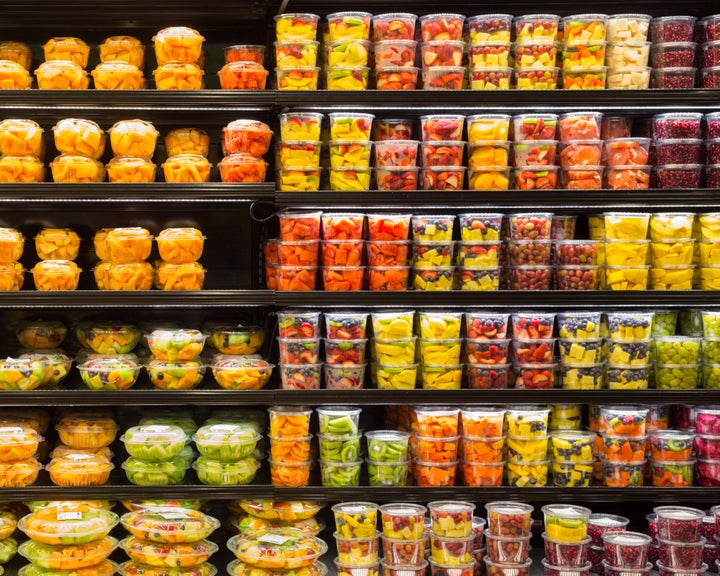Most Americans have been cooking at home more during the COVID-19 pandemic, but cooking fatigue may be setting in nearly a year into the crisis. Purchasing precut fruits and vegetables is one way to bring more convenience to the kitchen ― even if it costs up to three times what the whole produce would cost you. But there are a few things you should know before you buy them.
“Precut fruit has some major downsides,” Max Lugavere, health and science journalist and author of “Genius Foods,” noted in an Instagram post a few months ago. Buying whole produce usually brings bigger benefits, he said.
“Generally speaking, I think that it’s better for most people to buy whole fruit from an economic standpoint; it’s going to be less expensive,” Lugavere told HuffPost. “From a food safety standpoint, fruit that is protected by a rind or a peel, there’s going to be very low risk of contamination with other foodborne pathogens, like salmonella and E. coli. I think that whole fruit is nutritionally the best option. It’s going to be fresher, also.”
Precut produce is definitely a timesaving option, Lugavere admitted. And for some people, it may be the only way they’ll realistically eat fruits and vegetables ― especially since it’s more accessible for older people or people with disabilities, who may have trouble cutting or peeling. For those reasons, no one’s suggesting you altogether stop buying precut produce.
But there are certainly cons to precut fruits and vegetables, so we asked food safety experts to unpack some of the issues.
Precut produce is more susceptible to contamination
About half of all foodborne illnesses in the U.S. stem from fresh produce contaminated with salmonella, E. coli or listeria, according to the Centers for Disease Control and Prevention. When fruits and vegetables are handled more, such as by cutting and peeling, the risk goes up, said Bob Brackett, director of the Institute for Food Safety and Health at the Illinois Institute of Technology.
“With cut fruits and vegetables, you may only have one piece that actually has, say, salmonella or listeria on it,” Brackett explained. “But, when you cut it up and start mixing it, it now cross-contaminates the entire contents of your mixing bowl. And, it’s just inherently adding more risk any time you have human beings handling the food.”
Cooking could kill some of the bacteria, but lots of produce is consumed raw, heightening the risk. Any precut, bagged or packaged fruits or vegetables also need to be refrigerated or surrounded by ice, both in your own kitchen and in the grocery store. Don’t buy it if they’re not, the U.S. Food and Drug Administration says.
Nutrients may be lost through oxidation
Cutting or peeling fruits and vegetables exposes their insides to light and air. This causes oxidation, which could affect the texture, color or taste. They might start to lose nutrients if they sit for a while, too.
Water-soluble vitamins, like vitamin C and vitimin B, and some antioxidants are especially sensitive to oxidation, Lugavere said. “You can see that when you cut open an avocado and the flesh turns brown, or the same thing with an apple,” he explained.
That doesn’t necessarily mean precut fruits and vegetables aren’t nutritious, though. You’ll still get the water and fiber content, and some vitamins, Lugavere said. Just try to eat them as soon as you can after purchase.
Precut produce has a shorter shelf life
Since precut fruits and vegetables are vulnerable to oxidation, they won’t last as long as the whole versions that are protected by a rind or skin. So, paying attention to sell-by, use-by or best-by dates is critical. Look for products with the most recent date, as they were prepared most recently, Brackett said.

“I tend to reach for the fruit in the back, because that’s where they put the freshest stuff,” Lugavere said. “That’s one way to sort of hack the system.”
When you get home, refrigerate the items immediately at 40 degrees Fahrenheit or below, according to the FDA. “Use your oldest one first, and then later eat the one that’s been around soonest,” Brackett said.
Precut produce is more expensive and comes with lots of plastic
Precut fruits and vegetables tend to be pricier than their whole counterparts. In 2018, Vice found that precut produce was up to three times more expensive. For example, a whole head of romaine lettuce cost $1.99, but a 22-ounce bag ran $3.99. A whole pineapple cost $2.99 a pound, but $4.99 a pound when it was chopped.
The products are also often packaged in plastic, which poses a serious environmental impact. And, some of the chemicals in plastic could seep into the food and be toxic.
“For the value, for the nutritional bang for the buck, for the fact that you’re not using single-use plastic, I think buying a whole fruit is going to be the best option,” Lugavere said.
But, precut produce could get people to eat more fruits and vegetables
Precut vegetables and fruits save the time and hassle of having to cut, peel or chop. And that’s the main draw, Brackett said.
“More people, I think, because of cut produce, are eating more fresh fruits and vegetables, and that’s a good thing from a nutritional point of view,” he said. “If they’ve got to cut it up themselves, they’re less likely to even bother, so it’s a good way to encourage people to have a more balanced diet.”
Still, if you’re still planning to buy precut fruits and vegetables, Brackett emphasized that storing and handling them correctly is vital, and to only purchase them from reputable grocery stores where you shop regularly.